#National Zoological Park
Explore tagged Tumblr posts
Text
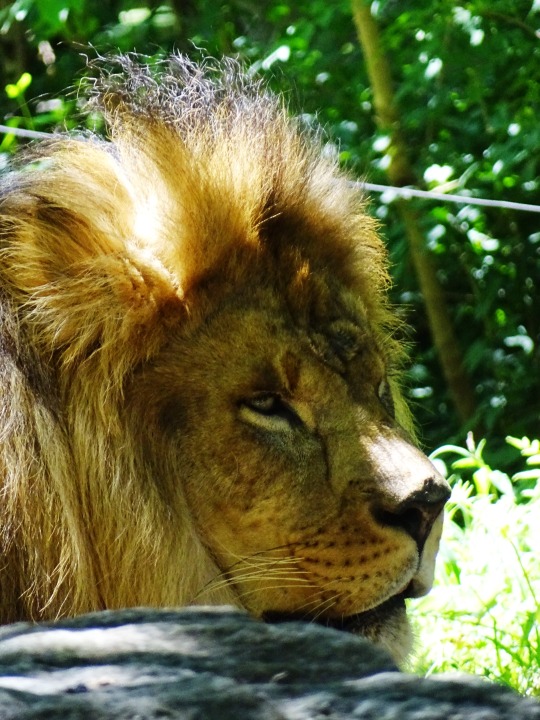

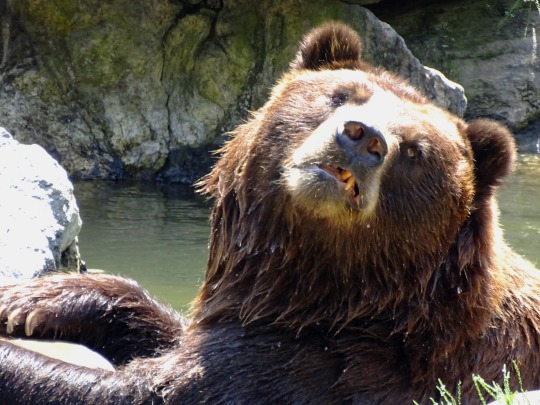

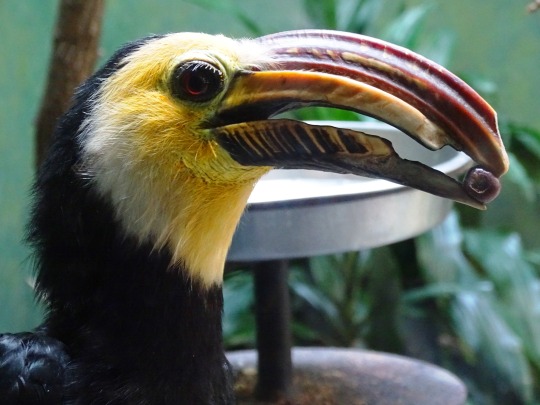

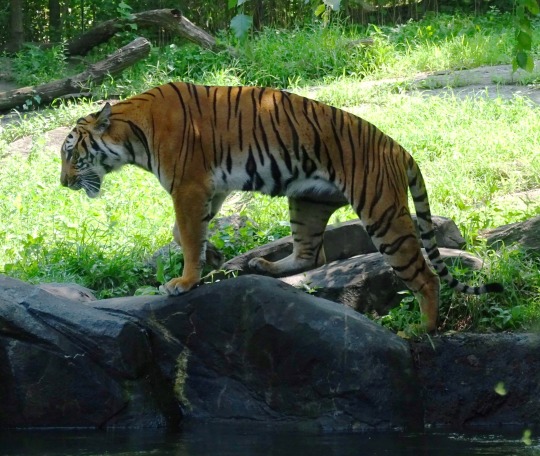


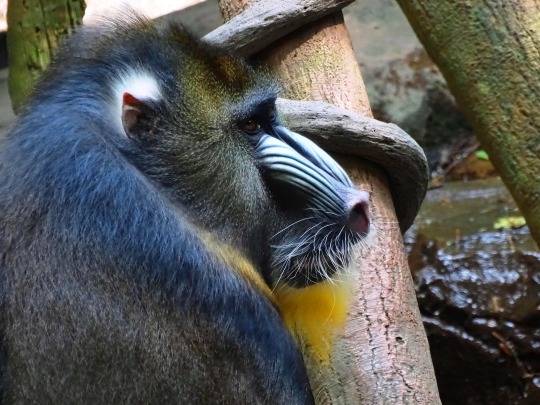
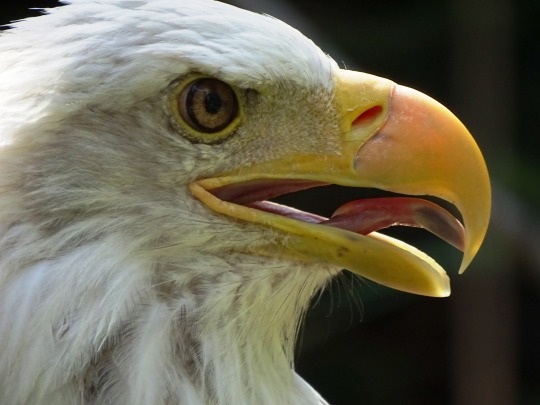




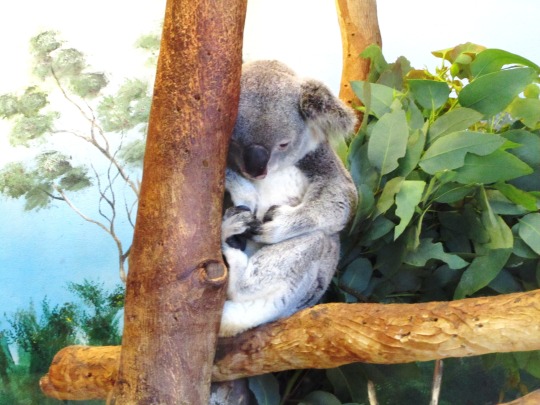





American Zoo Day
Philadelphia has always been an important city in America. It is one of the top ten biggest cities in the country, and once was the second biggest. It is also home to important historical artifacts and buildings such as the Liberty Bell and Independence Hall, as well as the nation's first zoo, the Philadelphia Zoo, which opened on July 1, 1874. Today we celebrate this zoo, along with other American zoos!
A Zoo—short for a zoological park—is a place that contains animals and exists to entertain, educate, engage in scientific research, and focus on conservation. Early zoos, known as menageries, were private collections of animals held by the wealthy. They existed as early as 2,500 BCE, being found in Egypt and Mesopotamia. They were found soon afterward in ancient China, Greece, and Rome. Aztec Emperor Montezuma II had one of the first collections of animals in the Western Hemisphere.
Modern zoos came about during the age of Enlightenment. One of the focuses of the era was on science, and this extended to zoology. There was an increased interest to study animals, with the goal of better understanding their behavior and anatomy. In order to do this more accurately, animals needed to be observed in more natural habitats. This was a driving force behind the establishment of modern zoos.
One of the first modern zoos, Menagerie du Jardin des Plantes, opened in Paris, France, in 1793. This followed the French Revolution; the menageries of the aristocrats, including those of the king and queen, were used to start the zoo. This early zoo did not have much for natural habitat, though, and was set up more like a museum, having small display areas.
Shortly thereafter in America, in 1804, Thomas Jefferson sent Lewis and Clark on an expedition out West to find and document the animals living there. This demonstrated the new country's interest in animals, but the country was not quite ready for a zoo. When the London Zoo opened to the public in 1847, it influenced some in the United States to start thinking that it was time to open their own zoo.
A physician named William Camac spearheaded the cause for a zoo in Philadelphia. On March 21, 1859, the Pennsylvania State Legislature voted to establish the Philadelphia Zoological Society, and Camac became its president. The Society—the first of its kind in the United States—worked to raise public and private funds to build the zoo. With the start of the Civil War in 1861, the plans were put on hold, as money was not available to devote to the zoo until after the war.
Eventually, the Zoological Society was given 30 acres of land in Fairmount Park on the banks of the Schuylkill River. "The Solitude," a house built by John Penn, the grandson of William Penn—the founder of the province of Pennsylvania—was included on the land. The size of the zoo was later extended to 42 acres. The entryway included a wrought-iron gateway and gatehouses designed by Frank Furness, which are still in use today.
On opening day, 3,000 people visited the zoo and were welcomed by a brass band and flags. Adults were charged 25 cents for admission, while children were charged 10 cents—this was the cost of admission for the next half-century. Yearly memberships were available for 10 dollars, with lifetime memberships being 50 dollars. During its first year of operation, 228,000 people visited the zoo. Today it has 1.2 million visitors each year.
There originally were 616 animals (another account says 813) at the zoo, some of which were on loan from the Smithsonian Institution. The Smithsonian had collected them from Africa and Asia but did not yet have their own zoo in Washington D.C. to house them at. The zoo had 3,000 animals by 1976 but then began downsizing to the 1,300 it now has. Today we celebrate the animals at this zoo, the zoo itself, and those all across America.
How to Observe American Zoo Day
The best way to celebrate the day is to take a trip to the Philadelphia Zoo. If you can't make it to Philadelphia, perhaps you are nearby one of the best zoos in the country. Otherwise, find another nearby zoo to visit!
Source
#Bronx Zoo#my favorite zoo#New York City#San Diego Zoo#Lincoln Park Zoo#Chicago#Washington DC#travel#original photography#vacation#tourist attraction#cityscape#animal#National Zoological Park#USA#American Zoo Day#AmericanZooDay#1 July#nature#flora#fauna#bear#tiger#bald eagle#nile crocodile#polar bear#giant panda#koala#ara#zebra
4 notes
·
View notes
Text
Exploring the Garden of Five Senses in Delhi: A Sensory Delight
Delhi, the bustling capital of India, is known for its rich history, vibrant culture, and stunning architecture. Amidst the chaos and clamor of this metropolis lies an oasis of tranquility and beauty—the Garden of Five Senses. This enchanting garden is designed to stimulate all five senses, offering visitors a unique experience that combines nature, art, and culture. In addition to the Garden of Five Senses in Delhi, another notable attraction that captivates tourists is the National Zoological Park. This article delves into the allure of the Garden of Five Senses, its features, and why it is a must-visit destination for both locals and tourists.

Introduction to the Garden of Five Senses in Delhi
The Garden of Five Senses in Delhi is not just a park but an amalgamation of nature's beauty and human creativity. Spread over 20 acres, this garden is located in the Said-Ul-Azaib village near the Mehrauli heritage area. It was developed by Delhi Tourism and Transportation Development Corporation (DTTDC) and opened to the public in February 2003. The primary objective of this garden is to provide a space where people can relax, rejuvenate, and experience the beauty of nature in its full glory.
A Sensory Journey
The garden is aptly named the Garden of Five Senses because it is designed to engage all five human senses—sight, sound, smell, touch, and taste. Every corner of this garden is crafted to provide a sensory delight, making it a unique destination for visitors of all ages.
Features of the Garden of Five Senses
1. Sight: Visual Extravaganza
As you enter the Garden of Five Senses, you are greeted by a riot of colors. The garden boasts a variety of flowering plants, trees, and shrubs that create a visual feast. The landscaping is done in such a way that it changes with the seasons, offering a different spectacle each time you visit. The garden is divided into distinct sections, each with its own theme and design.
Khas Bagh: Inspired by the Mughal Gardens, Khas Bagh features a central water channel, cascading fountains, and geometrically arranged flower beds. The symmetry and precision in this section are reminiscent of the gardens of the Mughal era.
Herbal Garden: This section is dedicated to medicinal and aromatic plants. It is not only visually appealing but also educational, as visitors can learn about the various uses of these plants.
Color Gardens: These gardens are designed to showcase a spectrum of colors. Different sections are dedicated to different color themes, creating a vibrant and dynamic visual experience.
2. Sound: Symphony of Nature
The Garden of Five Senses is designed to enhance the auditory experience of visitors. The sound of water cascading from fountains, the rustling of leaves, and the chirping of birds create a natural symphony that is soothing to the ears. The garden also hosts cultural events, live music performances, and art exhibitions, adding to the auditory pleasure.
3. Smell: Aromatic Bliss
The air in the Garden of Five Senses is filled with the fragrance of blooming flowers and aromatic plants. The Herbal Garden and the Color Gardens are particularly notable for their delightful scents. The garden also features a section dedicated to fragrant flowers, ensuring that every breath you take is filled with aromatic bliss.
4. Touch: Tactile Engagement
The garden encourages visitors to engage their sense of touch through various interactive installations and textured surfaces. The pathways are designed with different materials like pebbles, sand, and grass, inviting visitors to walk barefoot and feel the different textures. There are also sculptures and installations that are meant to be touched, providing a tactile experience.
5. Taste: Culinary Delights
The Garden of Five Senses features a food and shopping court where visitors can indulge in a variety of culinary delights. From traditional Indian snacks to international cuisines, the food court offers a range of options to tantalize your taste buds. This section of the garden ensures that the sense of taste is not left behind in this sensory journey.

Exploring the Garden
Sculpture Garden
One of the highlights of the Garden of Five Senses is the Sculpture Garden. This section showcases the works of various artists and sculptors, blending art seamlessly with nature. The sculptures are strategically placed amidst the greenery, creating a harmonious balance between art and environment. The Sculpture Garden is a visual treat and provides a platform for artists to display their creativity.
Neel Bagh
Neel Bagh, or the Blue Garden, is another fascinating section of the Garden of Five Senses. It features a lily pond with blue ceramic tiles and is surrounded by bamboo groves. The tranquil ambiance and the soothing sound of water make Neel Bagh a perfect spot for meditation and relaxation.
Amphitheater
The garden also houses an open-air amphitheater that hosts various cultural events, performances, and workshops. The amphitheater is designed to blend with the natural surroundings, providing a picturesque backdrop for any event. It is a popular venue for music concerts, dance performances, and theater productions.
Solar Energy Park
A unique feature of the Garden of Five Senses is the Solar Energy Park. This section is dedicated to promoting awareness about renewable energy sources. It features solar-powered installations and interactive exhibits that educate visitors about the benefits of solar energy. The Solar Energy Park is an educational and inspirational addition to the garden.

National Zoological Park: A Nearby Attraction
While visiting the Garden of Five Senses in Delhi, another nearby attraction worth exploring is the National Zoological Park. Located near the Old Fort in Delhi, the National Zoological Park, commonly known as the Delhi Zoo, is home to a wide variety of animals and birds. Spanning over 176 acres, the zoo provides a natural habitat for its inhabitants and offers visitors an opportunity to observe wildlife up close.
Highlights of the National Zoological Park
Exotic Wildlife: The zoo houses a diverse range of species, including lions, tigers, leopards, elephants, and rhinoceroses. It also features a variety of birds, reptiles, and amphibians.
Conservation Efforts: The National Zoological Park is involved in various conservation and breeding programs for endangered species. It plays a crucial role in the preservation of biodiversity.
Educational Programs: The zoo offers educational programs and guided tours, making it an excellent destination for school trips and family outings. Visitors can learn about wildlife conservation, animal behavior, and the importance of protecting natural habitats.
Conclusion: A Perfect Blend of Sensory and Wildlife Experiences
The Garden of Five Senses in Delhi is a unique destination that offers a multi-sensory experience, making it a perfect getaway from the city's hustle and bustle. Its combination of natural beauty, artistic installations, and cultural events makes it a must-visit for anyone seeking relaxation and inspiration. The proximity of the National Zoological Park adds to the appeal, providing an opportunity to explore wildlife and learn about conservation efforts.
For corporate groups, the garden and its surroundings also offer an ideal setting for team-building activities and corporate outings. The serene environment, coupled with the engaging sensory experiences, can help foster creativity, improve communication, and strengthen team bonds. The Garden of Five Senses, with its diverse attractions and serene ambiance, is undoubtedly a jewel in Delhi's crown, promising an unforgettable experience for all who visit.
0 notes
Text
A notorious zoo in North West England is finally closing at the end of the year, long time coming as they've had severe publicised problems since 2017 including animals harming themselves on hazards in their cages, needless accidental deaths, and the zoo not paying for food for the animals. The last one was corroborated by a local supermarket who said keepers would beg unsellable or damaged fruit and veg for the animals. Recently there's also been allegations of abuse and bullying within the human team, which isn't surprising when you consider the strain on them.
I was extremely happy when I saw the news and have been keeping up with planned placements for the animals in the area's local paper. Made the mistake of reading the comments, which was a waste of time, turns out far from being concerned about the animals these weirdos are convinced a 'woke lefty mob' caused this? I get that animal rights activists who are anti all zoos are always the first to celebrate these things, and possibly could be described as a woke lefty mob if that's your bent, but in this case there's no way only fully anti captivity people would be against this place. It was SO bad. If you followed the case at all, pictures of the animals with sores and injuries were very hard to avoid.
As someone who visited the zoo c2007 before the publicised troubles when it got really really bad, and in that one visit witnessed an animal escape which I'd never seen anywhere before or since (and it seemed like it happened regularly at this zoo from the reactions of the staff), I have always been baffled by people defending this place, and I suppose it makes sense some of them have to use their fav words to justify it. I guess now it's a culture war whether animals in captivity should be safe from injury and death caused by negligent care. That's depressing.
#some of them were saying the supposed animal rights activists should be responsible for rehoming the animals#yeah thats how that works in the zoological network 😂#also im not convinced this even happened because of activist pressure#its been dying a slow death for a decade and more#now the staff are falling apart as well as the animals how could it ever keep going?#the north west is a deprived area so i get worry about tourism losses but this place is riiight next to a huge national park#which brings in tonnes of tourism...give them something to do they will come to you#i cant imagine many were visiting this zoo any more after so much bad press
1 note
·
View note
Text
Explore Odisha !!!
#ExploreOdisha !!! #JagannathTemplePuri #KonarkSunTemple #LingarajTemple #ChilikaLake #Daringbadi #BhitarkanikaNationalPark #NandankananZoologicalPark #Odisha #HistoricalTemples #NationalPark #FamilyHoliday #Travel #TravelPackage #TourPackage #DomesticTour #TravelAgentInRajkot #TourOperatorInRajkot #CarHireInRajkot #CarOnRentInRajkot #Adler #AdlerTours #AdlerToursSafaris…
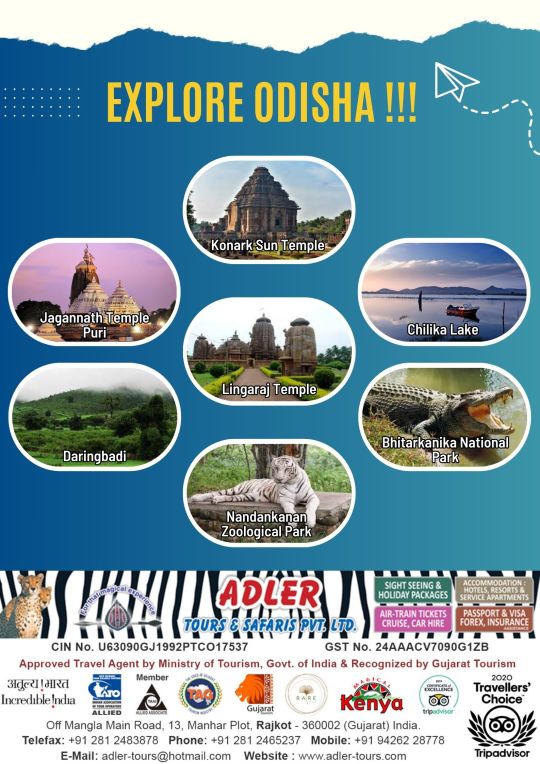
View On WordPress
#Adler Tours#Adler Tours & Safaris#Adler Tours and Safaris#Asia#bhitarkanika National Park#Chilika Lake#Daringbadi#Explore Odisha#family Holidays#Gujarat#India#Jagannath Puri Temple#Konark Sun Temple#Lingaraj Temple#Nandankanan Zoological Park#Odisha#Rajkot#Travel
0 notes
Text
Exploring the National Zoological Park Delhi: A Wildlife Haven
Source- Business Upside India
The Delhi Zoo, sometimes called the National Zoological Park Delhi, is a vast green haven in the middle of India's busy metropolis. This 176-acre zoo was founded in 1959 and is a major hub for animal education and conservation in addition to being a well-liked tourism destination. With its abundant biodiversity and well-kept habitats, the zoo provides a singular chance to see and discover creatures from all over the world.
A Brief History
The goal of establishing a location where people may interact with nature and wildlife was the driving force behind the establishment of the National Zoological Park Delhi. The zoo has developed into an important hub for conservation over time, raising rare animals and carrying out studies to support the preservation of biodiversity.
Read More
1 note
·
View note
Text
Nothing beats a firsthand encounter with nature; children, in particular, learn a lot when they are close to the elements. You may get up close and personal with the animals when you go to the zoo. A location where people of all ages may enjoy seeing wildlife in their natural surroundings. Hiking and spending a day at the zoo, seeing various animals, feeding them, and remaining close to nature are both enjoyable activities. And, for a close look at the country’s fauna, don’t miss out on these Zoological Parks in India.
0 notes
Text
The Woodland Park Zoo is my home zoo, and the possibility of a strike has been brewing for a while. The staff at the zoo have been working without a union contract for over 200 days because the zoo is unwilling to pay them a living wage.
Zookeepers around the country are consistently underpaid, and Seattle is an incredibly expensive place to live. The zoo is losing animal care staff rapidly - I've been told they'd lost five keepers and a vet tech to another nearby AZA zoo this year alone - because they can't afford to live here. And I've been told that because there's no contract, the zoo is on a hiring freeze, which means they're perpetually understaffed.

Photo credit: Yulia Issa
There was an informational picket outside of a big event last month, which got a ton of community support. Then the only content the zoo put out for National Zookeepers Week was a single post about how much gratitude the staff are owed, which... hmmmm, came off a little tone-deaf in the current moment.

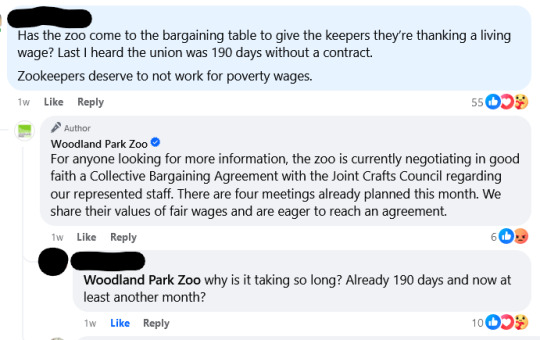
Now it looks like staff might end up striking to make their point, after almost a year of negotiations.
"Workers at Woodland Park Zoo, who are members of the Joint Crafts Council (JCC) Coalition of Unions, have been making plans to protect the animals if they go on strike. If the group of 200 workers is unable to reach an agreement with their employer over a new contract, they say they will run a skeleton crew that would provide necessary care to the animals but require the Zoo to close its doors to the general public. “We are making contingency plans to ensure the continued well-being of the animals if we are forced to strike,” said Janel Kempf, a learning coordinator who has been with the Zoo for 25 years and is a Shop Steward with Teamsters 117. “A strike is an absolute last resort and one that none of us takes lightly, but the Zoo keeps pushing us in that direction. If the Zoo doesn’t change course soon, we will have no other choice than to withhold our labor.” Negotiations between the Coalition of Unions and the Zoo have been ongoing for the last ten months with workers growing increasingly frustrated at what they say is the Zoo’s failure to value and retain an experienced workforce. “We are hemorrhaging critical animal care experience which directly affects the standard of care we can provide for our animals,” said Allison Cloud, an animal keeper and member of Teamsters 117. “The Zoo is forcing us to choose between our livelihoods and our animals, a heartbreaking decision no zookeeper ever wants to make.” Workers say low wages, the skyrocketing cost of healthcare, low morale, and high turnover have put the Zoo’s AZA accreditation at risk. Loss of accreditation could cripple the Zoo’s resources and lead to the transfer of animals to other accredited facilities. "Woodland Park Zoo cannot maintain AZA accreditation without us,” said Joe Gallenbach, an Exhibit Technician with IATSE Local 15. “The loss of AZA accreditation would demonstrate catastrophic mismanagement on the part of the Woodland Park Zoological Society.” The Coalition of Unions and the Zoo have one more bargaining session on the calendar: Friday, August 9. If the Zoo does not make an acceptable proposal next Friday, workers say they will take their case for fair wages and benefits to the public through direct, concerted action."
Now, when you bring the risk of AZA accreditation loss into the conversation, things get interesting. I've written before about how some zoos are legally or contractually obligated to maintain AZA accreditation and couldn't choose to leave. Woodland Park Zoo is one of those facilities: the agreement with the city that allows the Woodland Park Zoological Society requires them to be AZA accredited. If they lose it, they default on the agreement.

So, would there actually be a chance the facility could lose accreditation if the staff struck? I couldn't find any recent information about staff at other AZA zoos striking and how it related to their accreditation cycle, but I did find this, in an AZA press release about how the Aquarium of the Bay lost accreditation a few months ago.
"Silver Spring, Md. (May 24, 2024) – The Association of Zoos and Aquariums (AZA) Accreditation Commission unanimously voted to rescind the accreditation of the Aquarium of the Bay. The independent Commission notified the institution on May 13, 2024, following its conclusion that the aquarium was not meeting accreditation standards in a number of key areas, including financial stability, staffing capabilities, and employee morale and turnover. Aquarium of the Bay has until June 13 to appeal the Commission’s decision."
So it looks like staffing issues and employee morale can definitely be things taken into consideration. Let's look at the AZA standards for more info. I found a couple standards that appear to be relevant:
7.3 "There must be an adequate number of trained paid and unpaid staff to care for the animals and to manage the institution’s diverse programs." Justification: "Although there is no set formula for prescribing the size of the staff (paid and unpaid), some of the criteria that may be used to define what is considered “adequate” include the number and type of species within the institution, the general condition of the animals and exhibits, and past staffing practices."
7.4 "Compensation for paid staff should be competitive with other similar positions in the local/regional/national market, as appropriate." Justification: "Institutions must be able to recruit and retain qualified paid staff. Competitive compensation is a key component in recruitment and retention of paid staff. Some positions can be successfully recruited for locally, while others are competitive on a more regional or national basis (e.g., animal care specialists)."
Both of those look like they could quite reasonably be an issue for WPZ at this point. They're losing paid staff due to low wages and operating understaffed due to the hiring freeze. Staff obviously aren't getting appropriate compensation if they're looking for jobs at nearby facilities that pay better.
Now, would the zoo actually lose accreditation if a strike came to pass? Honestly, I doubt it, because WPZ is too big a feather in AZA's cap for them to penalize them that harshly. Columbus - an equally prominent institution - got kicked because of a major public animal use scandal, but it was pretty clearly political because of how quickly they were re-accredited. I'd expect AZA might give WPZ a slap on the wrist, some stern public comment, maybe some minor penalties, but I'd be very surprised if they were willing to kick WPZ to the curb over something "just" as minor as a staffing problem.
Regardless, zoo staff deserve to be paid a living wage. I'll be really sad if the zoo is closed to a strike once the snow leopard cubs get old enough to debut - but I'd still rather the staff be paid a living wage than be able to see the fluffballs immediately. I want the people working at the zoos I visit to not be living in poverty. Zoo staff pub in an incredible amount of effort to care for animal collections and to facilitate the guest experience, and they should be able to do that without multiple roommates or three jobs. I know that the practical reality is that not all facilities can afford to pay their staff as highly as is ideal, but I'd expect a big zoo with reliable city funding to be able to do better. Supporting the zookeepers (and other zoo staff) is supporting the zoo.
I'll be keeping an eye on this going forward, both from a personal perspective (I'm a member, and I have a vested interest in what the organization I give money to does) and a professional interest in industry politics (what does AZA choose to do). I'll update if there's anything interesting on either end.
804 notes
·
View notes
Note
Don’t know if this is the right place to ask, but could you talk more about zoos? I’ve seen many people say that zoos are inherently exploitative and that we should instead focus on advocating for wildlife preserves, etc., but I’m not sure what to think of that. You seem to know a lot about wildlife protection, so what’s your opinion on this?
There are folks faaaar better than myself to talk about the issues of zoos specifically and I'll try to toss in some sources so you can go and learn more, but let me try and explain my mindset here.
Summary of my opinion on this: BOTH of these things can be poorly managed, and I broadly support both. They should exist in tandem. I am pro-accredited zoo and am extremely sensitive towards misinformation. I also do think the best place for animals to be is in their natural environment, but nature "preserves" aren't inherently perfect. They can also be prone to the capitalist (and colonialist) pressures that less informed people believe they're somehow immune to.
Because of the goal of my project being to make the setting of WC accurate to Northwestern England, my research is based on UK laws, ecology, and conservation programs.
On Zoos
On Nature Reserves
An Aside on Fortress Conservation
On Zoos
The legal definition of a Zoo in the UK (because that is what BB's ecological education is based around), as defined by the Zoo Licensing Act of 1981 (ZLA), is a "place where wild animals are kept for exhibition to the public," excluding circuses and pet shops (which are covered by different laws.)
This applies equally to private, for-profit zoos, as well as zoos run by wildlife charities and conservation organizations. Profit does not define a zoo. If there's a place trying to tell you it's not a zoo but a "sanctuary" or a "wildlife park," but you can still go visit and see captive wild animals, even if it's totally free, it's a marketing trick. Legally that is still a zoo in the UK.
(for fellow Americans; OUR definition is broader, more patchwork because we are 50 little countries in a trenchcoat, and can include collections of animals not displayed to the public.)
That said, there's a HUGE difference between Chester Zoo, run by the North of England Zoological Society, which personally holds the studbooks for maintaining the genetic diversity of 10 endangered species, has 134 captive breeding projects, cultivates 265 threatened plant species, and sends its members as consultants to United Nations conferences on climate change, and Sam Tiddles' Personal Zebra Pit.
Sam Tiddles' Personal Zebra Pit ONLY has to worry about the UK government. There's another standard zoos can hold themselves to if they want to get serious about conservation like Chester Zoo; Accreditation. There are two major zoo organizations in the UK, BIAZA and EAZA.
(Americans may wonder about AZA; that's ours. AZA, EAZA, and BIAZA are all members of the World Association of Aquariums and Zoos, or WAZA, but they are all individual organizations.)
A zoo going for EAZA's "accreditation" has to undergo an entire year of evaluation to make sure they fit the strict standards, and renewal is ongoing. You don't just earn it once. You have to keep your animal welfare up-to-date and in compliance or you will lose it.
The benefit of joining with an accredited org is that it puts the zoo into a huge network of other organizations. They work together for various conservation efforts.
There are DOZENS of species that were prevented from going extinct, and are being reintroduced back to their habitats, because of the work done by zoos. The scimitar-horned oryx, takhi, California condor, the Galapagos tortoise, etc. Some of these WERE extinct in the wild and wouldn't BE here if it hadn't been for zoos!
The San Diego zoo is preventing the last remaining hawaiian crows from embracing oblivion right now, a species for which SO LITTLE of its wild behavior is known they had to write the book on caring for them, and Chester zoo worked in tandem with the Uganda Wildlife Authority to provide tech and funding towards breakthroughs in surveying wild pangolins.
Don't get me wrong;
MOST zoos are not accredited,
nor is accreditation is REQUIRED to make a good zoo,
nor does it automatically PROVE nothing bad has happened in the zoo,
There are a lot more Sam Tiddles' Personal Zebra Pits than there are Chester Zoos.
That's worth talking about! We SHOULD be having conversations on things like,
Is it appropriate to keep and breed difficult, social megafauna, like elephants or cetaceans? What does the data say? Are there any circumstances where that would be okay, IF the data does confirm we can never provide enough space or stimulation to perfectly meet those species' needs?
How can we improve animal welfare for private zoos? Should we tighten up regulations on who can start or run one (yes)? Are there enough inspectors (no)?
Do those smaller zoos meaningfully contribute to better conservation? How do we know if they are properly educating their visitors? Can we prove this one way or the other?
Who watches the watchmen? Accreditation societies hold themselves accountable. Do these organizations truly have enough transparency?
(I don't agree with Born Free's ultimate conclusion that we should "phase out" zoos, but you should always understand the opposing arguments)
But bottom line of my opinion is; Good zoos are deeply important, and they have a tangible benefit to wildlife conservation. Anyone who tries to tell you that "zoos are inherently unethical" either knows very little about zoos or real conservation work, or... is hiding some deeper, more batshit take, like "having wild animals in any kind of captivity is unlawful imprisonment."
(you'll also get a lot more work done in regulating the exotic animal trade in the UK if you go after private owners, btw. zoos have nothing to do with how lax those laws are.)
Anyway I'm a funny cat blog about battle kitties, and the stuff I do for BB is to educate about the ecosystem of Northern England. If you want to know more about zoos, debunking misconceptions, and critiques from someone with more personal experience, go talk to @why-animals-do-the-thing!
Keep in mind though, again, they talk about American zoos, where this post was written with the UK in mind.
(and even then, England specifically. ALL UK members and also the Isle of Man have differences in their laws.)
(If anyone has other zoo education tumblr blogs in mind, especially if they are European, lmk and I'll edit this post)
On Nature Reserves
Remember how broad the legal definition of a zoo actually was? Same thing over here. A "nature reserve" in the UK is a broad, unofficial generic term for several things. It doesn't inherently involve statutory protection, either, meaning there's some situations where there's no laws to hold anyone accountable for damage
These are the "nature reserve" types relevant to my project; (NOTE: Ramsar sites, SACs, and SPAs are EU-related and honestly, I do not know how Brexit has effected them, if at all, so I won't be explaining something I don't understand.)
Local Wildlife Site (LWS) Selected via scientific survey and managed locally, connecting wildlife habitats together and keeping nature close to home. VERY important... and yet, incredibly prone to destruction because there aren't good reporting processes in place. Whenever a report comes out every few years, the Wildlife Trust says it often only gets data for 15% of all their registered sites, and 12% get destroyed in that timeframe.
Local Nature Reserve (LNR) A site that can be declared by a district or county council, if proven to have geographic, educational, biodiversity, or recreational value. The local authority manages this, BUT, the landowner can remain in control of the property and "lease" it out (and boy oh boy, landowners do some RIDICULOUS things)
National Nature Reserve (NNR) This is probably closest to what you think of when someone says "nature reserve." Designated by Natural England to protect significant habitat ranges and geographic formations, but still usually operates in tandem with private land owners who must get consent if they want to do something potentially damaging to the NNR.
Site of Special Scientific Interest (SSSI) (pronounced Triple S-I) A conservation designation for a particular place, assessed and defined by Natural England for its biological or geographic significance. SSSIs are protected areas, and often become the basis for NNRs, LNRs, Ramsar sites, SACs, SPAs, etc.
So you probably noticed that 3/4 of those needed to have the private ownership problem mentioned right in the summary, and it doesn't end there. Even fully government-managed NNRs and SSSIs work with the private sectors of forestry, tourism, and recreation.
We live under Capitalism; EVERYTHING has a profit motive, not just zoos.
I brushed over some of those factors in my Moorland Research Notes and DESPERATELY tried to stay succinct with them, but it was hard. The things that can happen to skirt around the UK's laws protecting wildlife could make an entire season of Monty Python sketches.
Protestors can angrily oppose felling silver birch (a "weed" in this context which can change the ecosystem) because it made a hike less 'pretty' and they don't understand heath management.
Management can be reluctant to ban dogs and horses for fear of backlash, even as they turn heath to sward before our eyes.
Reserves can be owned by Count Bloodsnurt who thinks crashing through the forest with a pack of dogs to exhaust an animal to death is a profitable traditional British passtime.
Or you can literally just pretend that you accidentally chased a deer for several hours and then killed it while innocently sending your baying hounds down a trail. (NOTE: I am pro-hunting, but not pro-animal cruelty.)
The Forestry Commission can slobber enthusiastically while replacing endangered wildlife habitats with non-native, invasive sitka spruce plantations, pretending most trees are equal while conveniently prioritizing profitable timber species.
I have STORIES to tell about the absolute Looney Tunes bullshit that's going on between conservationists and rich assholes who want to sell grouse hunting access, but I'll leave it at this fascinating tidbit about air guns and mannequins which are "totally, absolutely there for no nefarious reason at all, certainly not to prevent marsh harriers from nesting in an area where they also keep winding up mysteriously killed in illegal snares, no no no"
BUT. Since Nature Reserve isn't a hard defined legal concept, and any organization could get involved in local conservation in the UK, and just about anyone or anything could own one... IT'S CHESTER ZOO WITH THE STEEL CHAIR!!
They received a grant in 2021 to restore habitat to a stretch of 10 miles extending outside of their borders, working with TONS of other entities such as local government and conservation charities in the process. There's now 6,000 square meters of restored meadow, an orchard, new ponds, and maintained reedbeds, because of them.
It isn't just Chester Zoo, either. It's all over the UK. Durrel Wildlife, which runs Jersey Zoo, just acquired 18,500 acres to rewild in Perthshire. Citizen Zoo is working with the Beaver Trust to bring beavers back to London and is always looking for volunteers to help with their river projects, and the Edinburgh Zoo is equipped with gene labs being used to monitor and analyze the remaining populations of non-hybrid Scottish Wildcats.
The point being,
Nature preserves have problems too. They are not magical fairy kingdoms that you put up a fence around and then declare you Saved Nature Hooray! They need to be protected. They need to be continuously assessed. They are prone to capitalist pressures just like everything else on this hell planet. Go talk to my boy Karl he'll give you a hug about it.
"Nature Preserves" are NOT an "alternative" to zoos and vice versa. They do not do the same thing. A zoo is a center of education and wildlife research which displays exotic animals. A nature preserve is a parcel of native ecosystem. We need LOTS of nature preserves and we need them well-managed ASAP.
We could never just "replace" zoos with nature preserves, and we're nowhere near the amount of protected ecosystem space to start thinking of scaling back animals in captivity. Until King Arthur comes out of hibernation to save Britain, that's the world we live in.
An Aside
My project and my research is based on the isle of Great Britain. The more I learn about the ecosystems that are naturally found there, the more venomously I reject the old lie, "humans are a blight."
YOU are an animal. You're a big one, too. You know what the role of big animals in an ecosystem are? Change. Elephants knock over trees, wolves alter the course of rivers, bison fertilize the plains from coast-to-coast. In Great Britain, that's what hominids have done for 900,000 years, their populations ebbing and flowing with every ice age.
Early farming created the moors and grazing sheep and cattle maintain it, hosting hundreds of specialist species. Every old-growth forest has signs of ancient coppicing and pollarding, which create havens for wildlife when well-managed. Corn cockle evolved as a mimic of wheat seeds, so farmers would plant it over and over within their fields.
This garbage idea that humans are somehow "separate" from or "above" nature is poison. It's not true ANYWHERE.
It contributes to an idea that our very presence is somehow damaging to natural spaces, and to "protect" it, we have to completely leave it alone. NO! Absolutely NOT! There are places where we have to limit harvesting and foot traffic, but humans ALWAYS lived in nature.
Even the ecosystems that this mindset comes from rejects it, but this shit doesn't JUST get applied to British people who become alienated and disconnected from their surroundings to the point where they don't know what silver birch does.
It's DEADLY for the indigenous people who protect 80% of our most important ecosystems.
It's a weapon against the Maasai people, stopped from hunting or growing crops on their own land. It's violence for 9 San hunters shot at by a helicopter with a "kill poachers on-sight" policy, as one of the world's LARGEST diamond mines operates in the same motherfucking park. The Havasupai people are kept out of the Grand Canyon that they managed for generations because they might "collect too many nuts" and starve squirrels, Dukha reindeer herders suddenly get banned from chopping wood or fishing, and watch wolves decimate their animals in the absence of their herding dogs.
It's nightmare after nightmare of human displacement in the name of "conservation."
That all ties back to that mindset. This idea that nature is pure, "pristine," and should be totally untouched. There are some starting to call it Fortress Conservation.
You can't begin to understand the criticisms of modern conservation without acknowledging that we are still living under the influence of capitalism and colonialism. Those who fixate on speaking for "animals/nature/trees who don't have a voice" often seem to have no interest in the indigenous people who do.
Listen. There's no simple answer; and the solution will vary for each region.
Again, my project is within the UK, one of the most ecologically devastated areas in the world. There are bad zoos that the law allows a pass. There are incredible zoos that are vital to conservation, in and outside of the country. There's not enough nature preserves. The best ones that exist are often exploited for profit.
I hope that my silly little blog sparks an interest in a handful of people to understand more about their own local ecosystems, and teaches folks about the unique beauty even within a place as "boring" as England.
But, my straightforward statement is that I have no patience for nonconstructive, broad zoo slander that lumps together ALL of them, and open contempt for anyone who tries to sell nature preserves like a perfect, morally superior "alternative." We need them BOTH right now, and we need to acknowledge that zoos AND preserves have legal and ethical issues that aren't openly talked about.
#ALSO THAT GUIDE IVE BEEN WORKING ON IS DONE#Im just waiting for the input of the sensitivity readers bc I made a whole section on--#How ableis m might express in the different clans#And part of it became a thunder-callout post lmaooooo#Also this zoo doc has been sitting competed in my drafts for a while#All this to say that uh. I hope the strange place they visit in the upcoming se is not a zoo :J#I will hit it with a golf club if it is <3#Leaning heavily towards the 'oh no two DEMIGODS ended up in a zoo' idea#Which is objectively funnier#And you know what else is objectively funny. When these posts break orbit and then ppl are surprised that i am a kitty cat blog#Hal. It's about Cats.#Bone Babble
111 notes
·
View notes
Text
Animal of the Day!
Caspian Tiger (Panthera tigris virgata)
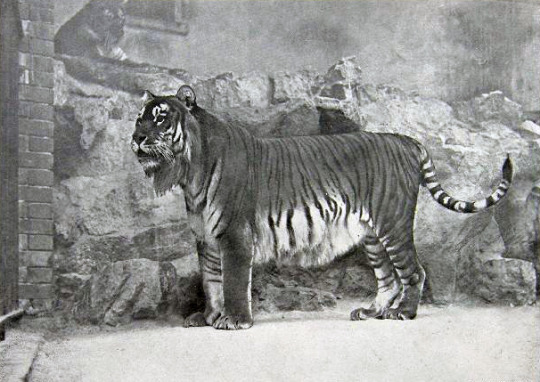
(Photo from Berlin Zoological Garden)
Extinction Date- 2003
Habitat- Middle East; Central Asia
Size (Weight/Length)- 230 kg; 3 m
Diet- Large mammals
Cool Facts- Caspian tigers were the second largest subspecies of tiger. They were made for rocky or forested steps by the Caspian Sea. These tigers were thought to follow migratory herds of deer or pigs. The downfall of the Caspian tiger began when Russia colonized Turkey. Tigers were shot out of fear, diseases swept through the population, and their natural habitat was converted into cotton plantations. The last wild Caspian tiger was captured and killed in 1997. Conservation efforts were attempted, but outside of legal protections little was done to restore their habitat or promote breeding attempts. Today, 6 tiger subspecies remain and all are endangered. Luckily, zoos are working to create captive breeding programs and national parks protect these magnificent creatures.
Rating- 12/10 (Most closely related to the Amur tiger.)
#animal of the day#animals#mammals#tigers#cats#tuesday#october 3#caspian tiger#biology#science#conservation#the more you know#extinct#extinctober#amur tiger
184 notes
·
View notes
Text

Ham the Chimp, often viewed as a hero at the same time as being viewed an unwitting victim in the infamous space race, was the first hominid launched into space on 31 January, 1961. Ham was one of the number of experimental animals enrolled into NASA’s Project Mercury.
Originally called subject 65 due to the reluctance to send a named chimp into space if anything were to go wrong, Ham was used as “a first test of the functioning of the life support system during an appreciable period – nearly five minutes – of zero gravity.”
His trainer described the moment he was recovered from his capsule following the project - “I have never seen such terror on a chimp’s face.” Following his flight, he spent the next 20 years alone in the National Zoological Park in Washington D.C. before being moved to North Carolina Zoo where he was able to mingle with other chimps. He passed away at the young age of 25.
After his death, his remains were buried at the International Space Hall of Fame and his skeleton was put on display at the National Museum of Health and Medicine.
123 notes
·
View notes
Text
Hunted to extinction in the wild in the 1960s, today there are nearly 1,000 Przewalski’s horses at three sites in Mongolia, with more in China and Kazakhstan. The biggest population – numbering 423 – is in central Mongolia’s Hustai national park, the descendants of 84 animals airlifted from European zoos in the 1990s.
Each year they attract tens of thousands of visitors to this small patch of pristine mountain steppe just 100km from the capital, Ulaanbaatar.
“Before the reintroduction, nobody believed we could save this species,” says Dashpurev, who runs Hustai national park. Since then, the International Union for Conservation of Nature (IUCN) has downgraded the risk status of Przewalski’s horse twice: “Our biggest achievement,” he says.
The success stands in stark contrast to other parts of Mongolia. Over the past three decades, the country’s wildlife has been decimated by a combination of hunting, the climate crisis and overgrazing, with creeping desertification turning huge tracts of its vast grasslands into dust.
“Mongolia’s wildlife is in crisis,” says Tungaa Ulambayar, the local representative of the Zoological Society of London. “It is in real danger of being wiped out.”
27 notes
·
View notes
Text





















American Zoo Day
Philadelphia has always been an important city in America. It is one of the top ten biggest cities in the country, and once was the second biggest. It is also home to important historical artifacts and buildings such as the Liberty Bell and Independence Hall, as well as the nation's first zoo, the Philadelphia Zoo, which opened on July 1, 1874. Today we celebrate this zoo, along with other American zoos!
A Zoo—short for a zoological park—is a place that contains animals and exists to entertain, educate, engage in scientific research, and focus on conservation. Early zoos, known as menageries, were private collections of animals held by the wealthy. They existed as early as 2,500 BCE, being found in Egypt and Mesopotamia. They were found soon afterward in ancient China, Greece, and Rome. Aztec Emperor Montezuma II had one of the first collections of animals in the Western Hemisphere.
Modern zoos came about during the age of Enlightenment. One of the focuses of the era was on science, and this extended to zoology. There was an increased interest to study animals, with the goal of better understanding their behavior and anatomy. In order to do this more accurately, animals needed to be observed in more natural habitats. This was a driving force behind the establishment of modern zoos.
One of the first modern zoos, Menagerie du Jardin des Plantes, opened in Paris, France, in 1793. This followed the French Revolution; the menageries of the aristocrats, including those of the king and queen, were used to start the zoo. This early zoo did not have much for natural habitat, though, and was set up more like a museum, having small display areas.
Shortly thereafter in America, in 1804, Thomas Jefferson sent Lewis and Clark on an expedition out West to find and document the animals living there. This demonstrated the new country's interest in animals, but the country was not quite ready for a zoo. When the London Zoo opened to the public in 1847, it influenced some in the United States to start thinking that it was time to open their own zoo.
A physician named William Camac spearheaded the cause for a zoo in Philadelphia. On March 21, 1859, the Pennsylvania State Legislature voted to establish the Philadelphia Zoological Society, and Camac became its president. The Society—the first of its kind in the United States—worked to raise public and private funds to build the zoo. With the start of the Civil War in 1861, the plans were put on hold, as money was not available to devote to the zoo until after the war.
Eventually, the Zoological Society was given 30 acres of land in Fairmount Park on the banks of the Schuylkill River. "The Solitude," a house built by John Penn, the grandson of William Penn—the founder of the province of Pennsylvania—was included on the land. The size of the zoo was later extended to 42 acres. The entryway included a wrought-iron gateway and gatehouses designed by Frank Furness, which are still in use today.
On opening day, 3,000 people visited the zoo and were welcomed by a brass band and flags. Adults were charged 25 cents for admission, while children were charged 10 cents—this was the cost of admission for the next half-century. Yearly memberships were available for 10 dollars, with lifetime memberships being 50 dollars. During its first year of operation, 228,000 people visited the zoo. Today it has 1.2 million visitors each year.
There originally were 616 animals (another account says 813) at the zoo, some of which were on loan from the Smithsonian Institution. The Smithsonian had collected them from Africa and Asia but did not yet have their own zoo in Washington D.C. to house them at. The zoo had 3,000 animals by 1976 but then began downsizing to the 1,300 it now has. Today we celebrate the animals at this zoo, the zoo itself, and those all across America.
How to Observe American Zoo Day
The best way to celebrate the day is to take a trip to the Philadelphia Zoo. If you can't make it to Philadelphia, perhaps you are nearby one of the best zoos in the country. Otherwise, find another nearby zoo to visit!
Source
#Bronx Zoo#my favorite zoo#New York City#San Diego Zoo#Lincoln Park Zoo#Chicago#Washington DC#travel#original photography#vacation#tourist attraction#cityscape#animal#National Zoological Park#USA#American Zoo Day#AmericanZooDay#1 July#nature#flora#fauna#bear#tiger#bald eagle#nile crocodile#polar bear#giant panda#koala#ara#zebra
0 notes
Text

Black Diamond was born in 1893 of a bull and cow given to the zoo by Barnum and Bailey (most reports claim his age to be 20 at the time of his demise)
The popular Indian Head, or Buffalo, five-cent coin (nickel) was introduced on February 22, 1913
Although aficionados prefer the name Buffalo Nickel, the official name of the coin is the Five Cent Indian Head.
1913. Designed by James Earle Fraser, a student of legendary sculptor Augustus Saint-Gaudens, the Indian Head/Buffalo nickel design showcases the native beauty of the American West ...
The obverse of the 1937 Buffalo or Indian Head nickel features an oversized bust of a Native American warrior. Unlike the later Sacagawea dollars, this design was not based on a single model or historical figure. Instead, sculptor James Earle Fraser created a composite image of three well-known men: Chief Iron Tail of the Sioux, Big Tree of the Kiowa, and Two Moons of the Cheyenne. This composite man wears two feathers woven into his hair and a braid running down the side of his head. On the 1937-D “3 Legged” type, there is significant die rust on the nape of the bust’s neck. The date (1937) is superimposed over the truncation of the bust, and the legend LIBERTY is off to the side at 2 o’clock on the rim.
Reverse :
The reverse was, however, based on a real buffalo named Black Diamond. This buffalo lived at the New York Central Park Zoological Garden. While standard types display all four legs, on this type the foreleg of the buffalo is missing. Additionally, the rear right leg is slightly weak. There can also be an arcing line of raised metal due to die rust in between the animal’s fore and rear legs ...
This gives rise to the coin’s unofficial name: “Urinating Buffalo”. The buffalo is standing on a small strip of land, below which is the denomination (FIVE CENTS) and mint mark (D). Arcing above the animal’s back around the rim is the legend UNITED STATES OF AMERICA. The motto E PLURIBUS UNUM is squeezed between “AMERICA” and the animal’s back.
Intriguingly, this design does not include the national motto IN GOD WE TRUST. Mint Director George Roberts informed Fraser that “the motto, ‘In God We Trust’, is not required upon this coin” (Burdette, 2007).
Edge: The edge of the 1937-D “3 Legged” Indian Head (Buffalo) nickel is plain or smooth, without lettering or inscriptions ...
9 notes
·
View notes
Text
IVE SEEN SOME
Smithsonian National Zoological Park in Washington D.C. !!!!



AHAHHAHAHAHHAAH WONDERFUL DAY







That last one is an orangutan 🤝
#siamang gibbon#Smithsonian#siamang#beautiful 😍#what a wonderful world#zoology#zoos#ape#gibbon#live laugh gibbon
8 notes
·
View notes
Text

Red Pandas, or Lesser Pandas, at National Zoological Park, 1973
Smithsonian Institution Archives, Acc. 11-009, Image No. 73-3841
Smithsonian Institution Collections
8 notes
·
View notes
Text
Dive into the wonders of the National Zoological Park Delhi, a sanctuary for diverse wildlife in the heart of India's capital. Read on.
1 note
·
View note